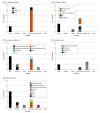Pathogen Surveillance for Acute Infectious Conjunctivitis
- PMID: 37917077
- PMCID: PMC10623299
- DOI: 10.1001/jamaophthalmol.2023.4785
Pathogen Surveillance for Acute Infectious Conjunctivitis
Abstract
Importance: Acute infectious conjunctivitis is a common ocular condition with major public health consequences.
Objective: To assess regional variations and microbial etiologies of acute infectious conjunctivitis to guide treatment.
Design, setting, and participants: In this cross-sectional study, patients with presumed acute infectious conjunctivitis were enrolled in the study at 5 sites (Honolulu, Hawaii; Los Angeles, San Francisco, and San Diego, California; and Petah-Tikva, Israel) from March 2021 to March 2023. Patients with allergic or toxic conjunctivitis were excluded.
Main outcomes and measures: Pathogens were identified by unbiased RNA deep sequencing.
Results: In all, 52 patients (mean [range] age, 48 [7-80] years; 31 females [60%]) were enrolled at 5 sites (6 patients from Honolulu, 9 from San Diego, 11 from Los Angeles, 13 from San Francisco, and 13 from Petah-Tikva). RNA deep sequencing detected human adenovirus species D in one-quarter of patients (13 of 52). A wide range of pathogens, including human coronavirus 229E, SARS-CoV-2, and herpes simplex virus type 1, was also identified, as well as several bacteria and fungi. Moreover, 62% (32 of 52) of patients presented with purulent discharge, while only 8% (4 of 52) of patients had confirmed bacterial pathogens.
Conclusion and relevance: In this cross-sectional study, pathogens associated with acute infectious conjunctivitis varied between all 5 sites in the US and Israel. Purulent discharge was a common presenting sign in this study, with a low specificity for bacteria-associated conjunctivitis, suggesting that further diagnostic workup may be necessary to inform antibiotic stewardship. Additional research on cost-effectiveness of using RNA deep sequencing is needed to ascertain whether it is better to monitor patients clinically until resolution of disease.
Conflict of interest statement
Figures
References
Publication types
MeSH terms
Grants and funding
LinkOut - more resources
Full Text Sources
Medical
Miscellaneous


